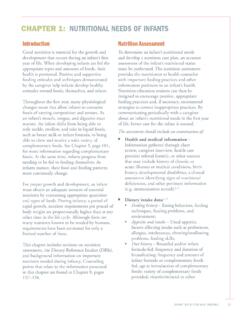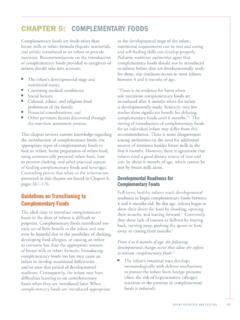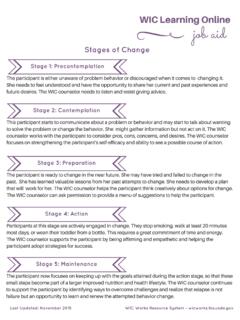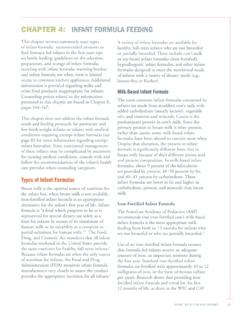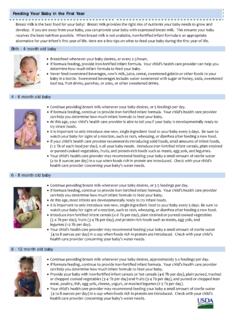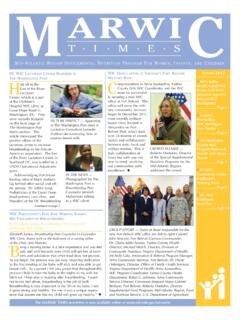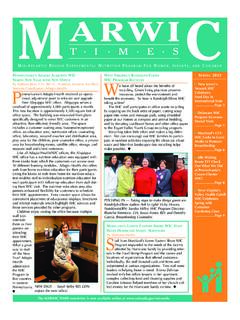Transcription of Secrets of Baby Behavior - USDA
1 Secrets of baby Behavior How to better understand your baby _____ WHO: WIC participants, mostly mothers, some fathers or caretakers of infants birth to 6 months old. Many come to the group session with their children. Some may be new mothers; others may have years of experience with infants. The topic will be presented in English and Spanish to participants of various educational levels and ethnic backgrounds. Approximately 2-15 participants per session. Educator is WIC staff (WNA or RD). One facilitator per group session. _____ WHY: Despite extensive nutrition education provided to WIC participants, many do not comply with infant-feeding guidelines. It is common for participants to formula-feed, overfeed, introduce solid foods early, or give inappropriate foods and fluids to infants. Recent focus groups of WIC mothers concluded that 22% introduced solid foods prior to 4 months old.
2 Some behavioral beliefs associated with the early introduction of solid foods were: o Babies cry because of hunger (formula and cereal prevent hunger) o When I gave formula, the baby no longer cried and slept, and that is when I decided not to give him breast milk. o Feeding solid foods is achieved as a developmental milestone rather than as a means to provide nutrients Future interventions (classes) must address issues that are important to mothers ( full=quiet sleeping infants).1 _____ WHEN: Group sessions are held during scheduled WIC visits. Estimated learning time is 30 minutes without starting solid foods section, 40-45 minutes with starting solids section. _____ WHERE: Sessions are conducted in the classrooms with chairs in a semi-circular arrangement. _____ WHAT: Infant cues-what is your baby trying to tell you and how should you respond?
3 Infant sleep-what is normal? Starting solid foods-new guidelines _____ WHAT By the end of this session you (the participant) will have: FOR: Shared what is great and what is stressful about being a new mom. 1. Recognized what normal infant sleep patterns look like. 2. Practiced reading and responding to a baby s cues. 3. Listened to and discussed the new infant-feeding guidelines 1 MATERIALS Posters: baby s Sleeping (Poster 1) Sweet Dreams (Poster 2) baby s Talking (Poster 3) Clues to Why Babies Cry (Poster 4) baby s Cues (Poster 5) There is brand new information (Poster 6) Why wait?
4 (Poster 7) We hope you have (Poster 8) Props: Cards for Sweet Dreams poster Photocopies of handprints Pre-made hand with reasons babies cry Materials: Flipchart or whiteboard & pens Sticky notes Handouts: Understanding Your baby s Cues Feed Me! Birth-6 mos. Healthy Sleep: For you and Your baby Why do Babies Cry? KEY Use flipchart Pass out handout Question for the group Pairs activity Hands on activity Writing activity HOW: (session directions follow) Introduction 1-2 minutes Welcome to Secrets of baby Behavior my name is _____ and I will be your group leader for this short interactive class.
5 The focus of our session is your baby from birth to 6 months old. Let s go around the room and have each of you introduce yourself and tell us how old your baby is. Let s 1. Warm Up 2 minutes As you all know, there are a lot of great things about being a new mom, but being a new mom can also be very stressful at times. First, tell me: what is great about being a new mom? (Wait for at least 3-4 responses. Probe if you need to. Write responses on flip chart or whiteboard. Affirm each response; for example: That s wonderful or Thank you for sharing. ) Now, tell me: What is stressful about being a new mom? (Wait for at least 3-4 responses. Probe for crying and waking up a lot if you need to. Write responses on flip chart or whiteboard. Affirm each response; for example: I can see how that would be stressful or I hear that all the time from new moms.)
6 Instructor: So it seems like being a mom is great AND stressful. From what you ve mentioned, it sounds like babies waking up a lot at night, crying, and not knowing what your baby needs is stressful for new moms. Let s spend a few minutes talking more about those things. 2. baby s Sleep-What is Normal? 4-5 minutes (SHOW POSTER- baby s Sleeping ) Instructor: Babies and adults sleep very differently. Babies sleep 13-14 hours per day from 2 -12 months old, but not all at one time. Babies and adults both wake up at night, but sometimes it is harder for babies to get back to sleep. Waking is actually very healthy for babies. Understanding why and when babies wake-up can help tired parents. Let s talk a little about HOW babies sleep: Have you noticed any signs that your baby is dreaming? (Pause at least 5 seconds for responses.)
7 Possible responses: smiles or cries in sleep, eye movement, body twitches, makes noises in sleep, etc.) 2 Yes, those are all signs that your baby is dreaming. When babies sleep, part of the time they sleep deeply and part of the time, they sleep lightly. During deep sleep (which we call quiet sleep), it is a lot harder to wake them up and they don t dream. During light sleep (which we call active sleep), babies dream and they are easy to wake- up. (SHOW POSTER- Sweet Dreams. As you read through the script below, put up the cards listed in bold up on the poster.) For babies, dreaming is very important because while they dream, blood flows up to their brains bringing nutrients and other things that they need for their brains to grow and develop. (Place up card that reads I will be very smart ) When they are dreaming, it is easier to wake babies up but babies have to wake-up sometimes to feed, to stay warm, and sometimes to breathe.
8 (Place up card that reads I will wake-up if I need your help ) So waking and dreaming are important to keep babies brains and bodies healthy. (Place up card that reads I will develop a healthy body ) We know it is tough, but the good news is that it doesn t last forever. As they get older, babies will wake-up less and less. (Place up card that reads I promise I will wake-up less and less as I get older ) It is also very important for babies to sleep on their backs. Babies will be able to wake-up more easily if they are having difficulty breathing when they sleep on their backs. This will help prevent your baby from developing a deadly condition called SIDS or Sudden Infant Death Syndrome. (Place up card that reads I will have less of a chance of dying from SIDS ) Many people think babies choke when put to sleep on their backs, but studies show this is not true.
9 Babies also spend more time in active sleep and dreaming when they sleep on their backs. This means babies that sleep on their backs might become healthier and smarter. 3 What surprised you about WHY babies dream? (Pause for responses.) What other questions do you have about your baby s sleep? Here is a handout with the information we just talked about and more. (Pass out Healthy Sleep handout) Understanding how babies sleep is just one way to help you better understand your baby . Now let s talk about how you can learn to communicate better with your baby . 3. What Babies Want: -Part 1- 3 minutes You and your baby have your own language that you use to talk to each other. Since babies can t talk, they have to use their bodies and noises to tell us what they want. 4 (SHOW POSTER: baby s Talking.)
10 Babies tell us they want to be near us by keeping their eyes open and their faces relaxed, like the baby on this poster. They might try to reach toward us, like this baby . They will also lift their faces and smile if they are old enough. Without talking, show the person next to you one way your baby tells you she wants to be near you. (Pair up the people sitting next to each other. If there are an odd number of people, the teacher should be someone s partner. Allow about 30 seconds for them to share with each other.) Who would like to share with the group how your baby tells you she wants to be near you? (Wait 5 seconds for a response. If no one wants to share, go right into the script below using the poster.) Without talking, show the person next to you one way your baby tells you he needs a break or something different. (Pair up the people sitting next to each other. If there are an odd number of people, the teacher should be someone s partner.)
